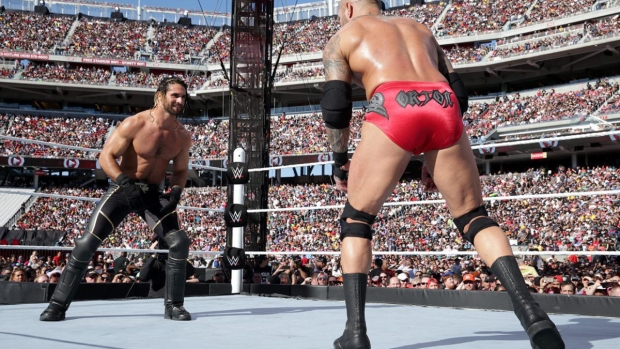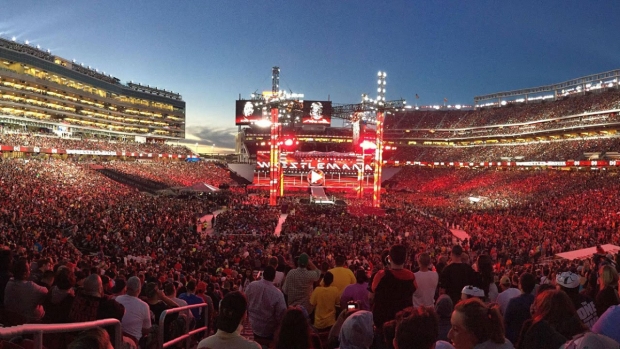World Wrestling Entertainment: Earth's Most Successful Traveling Theater
Two former WWE writers speak with TheaterMania about their time with the world’s wildest road show.

(© WWE)
If you ask a roomful of Broadway fans what the most successful touring show in the world is, you will probably hear a chorus of The Phantom of the Opera or Cats. Truly, both of these shows have made a mint over the years, particularly on tour: The official website for Phantom claims a worldwide gross in excess of $6 billion. While this is a staggering figure, built up over 29 years of constant performances around the world, there is one road show that consistently beats it, landing a cool half billion in annual sales: World Wrestling Entertainment (better known as WWE), the biggest name in professional wrestling.
"Wait a minute," you might say. "Professional wrestling is not theater." Oh, but it is: Unlike its freestyle and Greco-Roman cousins, pro wrestling traffics in whimsical costumes, sets, characters, and story lines — it is much closer to the stage than the Olympic podium. This is particularly true since the death of "kayfabe" (the practice of refusing to acknowledge that the wrestlers are playing roles and their matches are predetermined). The vast majority of wrestling fans are in on the secret: This is scripted theater. The major difference is that while a Broadway tour may stop at 2,000- to 3,500-seat houses (at most), the WWE regularly plays in front of sold-out arenas of 5,000 to 15,000. It is long past time we give WWE its due at the most vital theatrical enterprise of our time.

(© YouTube)
"It's the most lucrative traveling theater company in the world," agrees Matthew Lopes, a former writer for WWE. "It's performed in an international language, so anyone can enjoy it. It's opera, with underwear and fireworks." In addition to staging hundreds of "house shows" (untelevised live events) each year, WWE has two weekly television programs (Raw and SmackDown!) that perform in front of a live audience and are broadcast to millions of viewers worldwide. It would be as if the Tony Awards happened twice every week, pulling in millions of fans living far away from Broadway. This accessibility arguably makes pro wrestling America's most popular form of live theater…just don't call it fake.
While the dialogue is scripted and the matches predetermined, that doesn't mean the violence is "fake" (as detractors so often contend). "The athleticism is very real and so are the injuries," Lopes insists. Reporter John Stossel figured this out the hard way in 1984 when he confronted wrestler David Schultz (better known as Dr. Death) with his belief that it was all fake. "Dr. Death slaps the hell out of him," Lopes recalls.
Click here to see John Stossel try to take on Dr. Death:
Oh yes, the injuries in wrestling are real, as they are in dance or any other form of theater that requires physical exertion. While conditioning one's body for such a high-impact profession is still very much the prerogative of the individual performers, story issues are now exclusively handled by WWE.
Court Bauer wrote for WWE for two years (2005-2007). Now a producer for AAA (Mexico's biggest wrestling promoter), he's a frequent commenter on the business. According to Bauer, the turn of the century marked a big shift in the way WWE created shows. "There used to be guys called bookers or matchmakers," Bauer says. "A lot of them were former wrestlers and they wrote the shows." Around 2001, however, there was a big shift toward professional writers. "There used to be a lot more improvisation," he states. "Now it's very rigidly scripted." Struggling playwrights might want to take note.

(© YouTube)
Granted, writing a show for WWE is unlike anything on stage or television. Not only is there a writers' room in the company's Connecticut headquarters, but there's also a road team that travels around the country with the wrestlers. "When you combine those two, you have thirty people," Lopes says. He worked briefly at the Connecticut office before leaving for a job with Showtime's Ray Donovan. "At the end of the day, a lot of voices get lost."
Bauer agrees with this assessment. "You're a suggester," he says. "A writer for WWE should never own an idea too hard, because you've got to be able to let it go and have four or five more ideas ready." Ultimately, the last word on everything belongs to WWE chairman and CEO Vince McMahon.

(© Sgt. DaleAnne Maxwell)
Since purchasing WWE (then called WWF) from his father in 1982, McMahon has turned what was a series of loosely connected regional wrestling fiefdoms into a multinational media behemoth. He's done it largely through his massive force of will and shrewd sense of what plays and what doesn't. "Vince McMahon is a micromanager," Bauer says. "He has the final say on every product they put out."
In an age when the list of producers above the title on Broadway is becoming increasingly crowded, it seems incredible that the far larger WWE is still controlled almost entirely by one man. Like Florenz Ziegfeld or David Merrick before him, McMahon is an old-fashioned impresario taking a huge interest not just in the business but in creative aspects of his theatrical brand. "He's been doing this for more than forty years now," Bauer admits with a hint of grudging admiration. "He's outlasted everyone and built an empire."
Not only that, but he's successfully inserted himself into the story line. While he legitimately holds a commanding stake in the business, he also plays a nefarious version of himself onstage (this included a fair amount of actual wrestling in the late '90s and early '00s). Issues of corporate governance and labor relations regularly bleed into the ring. For instance, in 2011 Triple H (real name: Paul Levesque, executive VP of talent and McMahon's actual son-in-law) entered Green Bay's Resch Center and "fired" McMahon on behalf of the board of directors. Insiders largely agree that Levesque and wife, Stephanie McMahon (currently chief brand officer), are being groomed to take over the family business once the 70-year-old McMahon retires, not unlike the Nederlanders, but with a level of avant-garde metatheatricality that would make even the most experimental of downtown troupes blush.

(© Miguel Discart)
Of course, WWE is not charging off-off-Broadway prices for its house shows. Top tickets to live events regularly surpass $100, with premium events (like WrestleMania) commanding up to $1,000 per ticket. While critics regularly bemoan the high cost of Broadway tickets, producers might want to ponder how WWE charges even higher prices for its best seats and still manages to fill giant arenas (most events also offer nosebleed seats for under $30). Somehow, McMahon and company have convinced a large number of Americans to part with their hard-earned dollars for this popular form of folk theater.
Both Lopes and Bauer are doubtful that WWE's dominance can continue, with Bauer expressing the opinion that McMahon's success has led to a level of complacency. The scripted dialogue just isn't as authentic as the off-the-cuff old style of smack-talk. Also, all the talent is becoming cookie-cutter. "You used to be able to see a three-hundred-thirty-pound Samoan wrestle, but now they all look the same," Bauer observes. "WWE is essentially building a clone army of six-foot-two-inch, two-hundred-fifty-pound guys with tattoos and great abs." Not that there isn't a market for that.
For now, WWE doesn't appear to be going anywhere. Last year, McMahon launched a 24-hour streaming service (WWE Network), which very quickly garnered over a million subscribers. Those wrestling super-fans can watch their favorite stars whenever they want and then go out and buy a ticket to a live event, which they are doing in record numbers: Revenue for WWE's live events increased 81 percent in the first quarter of 2015 over the previous year. It should go without saying that expansion into new media doesn't cannibalize the profits of the live theater, but actually serve as a powerful promotional tool. Professional wrestling has figured this out, leaving us to wonder when the "legitimate" theater will catch up.








